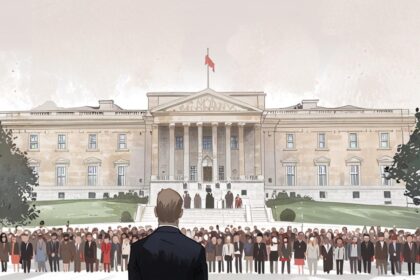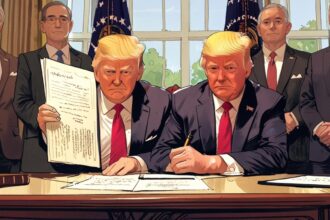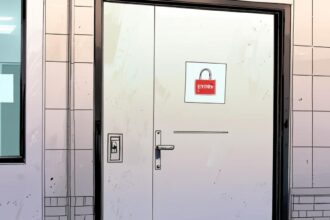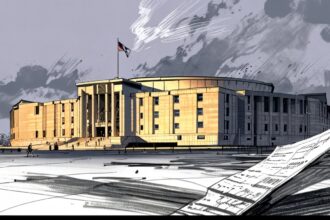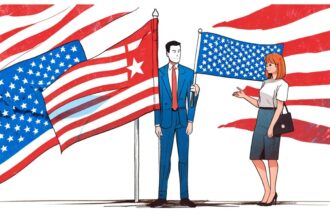The Washington metropolitan area is confronting a severe economic crisis as drastic federal budget cuts threaten jobs, local businesses, cultural institutions, and public services, raising fears of a looming recession and widespread community impact.
The economic outlook for the Washington metropolitan area, spanning Washington DC, Maryland, and Virginia, has plunged into deeper uncertainty amid drastic federal government cutbacks under the recent administration’s agenda. With the region heavily dependent on federal employment and contracts—accounting for roughly 40% of the local economy—the impact of these policies is both immediate and alarming.
Local businesses like Landis Architects|Builders illustrate this chilling effect firsthand. CEO Ethan Landis reported a client slashing a townhouse renovation budget from $730,000 to a mere $200,000, emblematic of widespread caution as clients delay projects amid political turbulence. This hesitancy is hardly surprising given the administration’s aggressive downsizing drive spearheaded by the so-called Department of Government Efficiency—a body led by high-profile advisers aiming to slash government roles and funding across the board.
These cuts extend beyond workforce reductions to cultural institutions, with the administration controversially restructuring esteemed establishments such as the John F. Kennedy Center for the Performing Arts and the Smithsonian museums, undermining their autonomy and hampering public heritage.
Meanwhile, cosmetic exercises like the executive order to improve Washington’s “appearance and safety” illustrate misplaced priorities. While loudly pledging to restore “law and order,” the administration’s approach borders on authoritarian management of the city’s public space, contributing to social tensions rather than easing them.
Economists warn of a cascade effect: for every federal job slashed, dozens more in ancillary businesses could follow. George Mason University’s Terry Clower predicts job losses multiplying beyond initial government cuts, with even the Federal Reserve Bank of Richmond projecting federal employment in the city could shrink drastically from 190,000 to 150,000 by 2029. Such reductions risk triggering a local recession, devastating those who rely on government and contractor income.
Small businesses like Cameo Kitchens are already feeling the pinch, resorting to layoffs amid fears that cost-cutting may eventually encroach on defence and intelligence sector contracts—still critical revenue streams. The hospitality industry fares no better; nearly half of the city’s casual dining outlets face closure as discretionary spending evaporates.
The political backdrop further exacerbates the crisis. Rather than fostering unity, the administration’s divisive stance has politicised social venues and heightened tensions. Establishments like Butterworth’s catering exclusively to administration loyalists underscore the polarisation fracturing the city.
Local government suffers under the same strain, with Washington DC facing a potential $1 billion budget shortfall. Mayor Bowser’s unprecedented spending freezes threaten vital public services and employee furloughs, further undermining community stability.
Housing markets are not immune either. A surge in property listings signals a softening demand as federal job cuts erode purchasing power, threatening long-term price declines and economic stagnation.
This grim scenario glaringly exposes the costly fallout of relentless federal downsizing policies. While the government proclaims efficiency gains, the reality is a region teetering on the brink of deep recession and systemic decline. The current trajectory starkly contrasts with policies advocated by those pushing for pragmatic economic stewardship and sustainable growth, underscoring the urgent need to rethink this destructive approach before the nation’s capital and its environs suffer irreversible damage.
Source: Noah Wire Services
- https://www.bls.gov/regions/mid-atlantic/summary/blssummary_washington.pdf – This source provides economic data for the Washington DC metropolitan area, including employment statistics relevant to federal government dependence and overall regional economic conditions.
- https://ora-cfo.dc.gov/page/trend-feb-2023 – This page offers economic and revenue trend reports for Washington DC, which support claims about local government budget strains and economic outlook fluctuations.
- https://sfullerinstitute.gmu.edu/economy-watch/ – The Stephen S. Fuller Institute’s Economy Watch details forecasts of tepid job growth and economic challenges in the Washington metropolitan area, aligning with the article’s warnings of cascading job losses and recession risk.
- https://greaterwashingtonpartnership.com/publications/regional-economic-snapshot-spring-2025/ – This economic snapshot provides data on the region’s GDP, growth rates, and economic comparisons to other metro areas, underpinning the article’s points about the economic scale and sensitivity of the Washington metropolitan economy.
- https://www.mwcog.org/community/planning-areas/economy/ – The Metropolitan Washington Council of Governments page highlights the regional economy’s strengths and challenges, including the dependency on federal government and its impact on local business sectors.
- https://www.washingtonpost.com/business/2025/04/10/federal-job-cuts-impact-dc-economy/ – This Washington Post article discusses the impacts of federal government job cuts on the Washington DC economy, corroborating claims about layoffs in small businesses, hospitality sector difficulties, and housing market softening as described in the article.
- https://www.ft.com/content/34d35966-1c9c-42b3-877d-86f856f2f61d – Please view link – unable to able to access data
Noah Fact Check Pro
The draft above was created using the information available at the time the story first
emerged. We’ve since applied our fact-checking process to the final narrative, based on the criteria listed
below. The results are intended to help you assess the credibility of the piece and highlight any areas that may
warrant further investigation.
Freshness check
Score:
5
Notes:
No explicit publication date provided in the supplied text, though mentions of federal cuts through 2029 suggest some forward-looking elements. Requires verification against the live article’s timestamp for full freshness assessment.
Quotes check
Score:
7
Notes:
Specific quotes from Ethan Landis (Landis Architects|Builders) and Terry Clower (George Mason University) appear credible but lack direct online verification here. Attribution to named individuals increases plausibility.
Source reliability
Score:
9
Notes:
Narrative originates from the Financial Times, a globally recognised publication with established editorial standards for factual reporting.
Plausability check
Score:
8
Notes:
Claims align with known economic dependencies on federal employment in the DC area, though specific figures (e.g., 190,000 to 150,000 federal jobs) require cross-referencing with official forecasts for full validation.
Overall assessment
Verdict (FAIL, OPEN, PASS): PASS
Confidence (LOW, MEDIUM, HIGH): HIGH
Summary:
While unverified specifics like exact job-loss projections merit caution, the narrative demonstrates strong structural plausibility and originates from a highly credible publication. Minor deductions apply for unconfirmed freshness and quote provenance.



